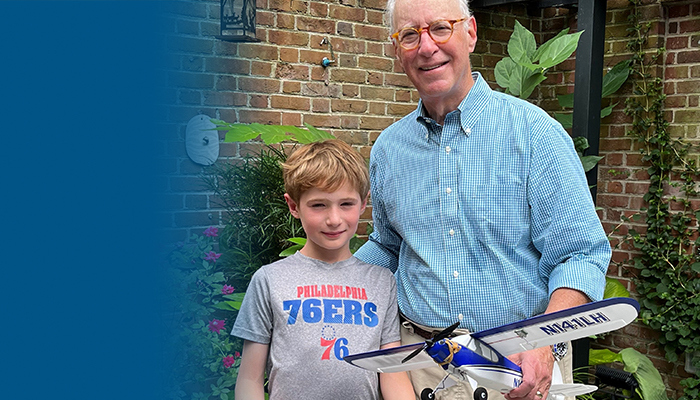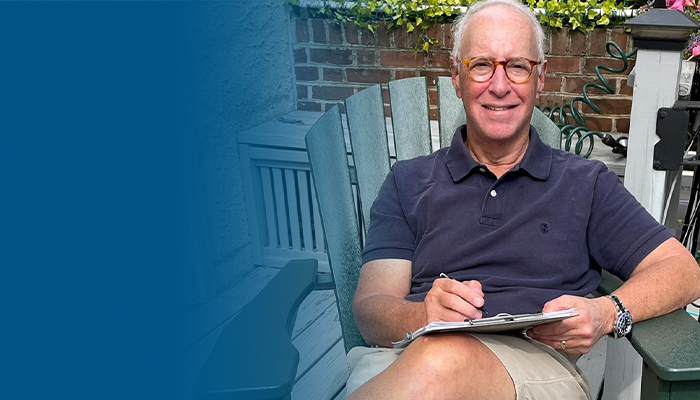HOW CAN WE HELP YOU? Call 1-800-TRY-CHOP
In This Section
Reaching New Heights With Crossword Puzzles and Radio-controlled Planes

A radio-controlled aircraft enthusiast, Dr. Michael Levine shares his hobby and time with grandson Caleb.
mccannn [at] email.chop.edu (By Nancy McCann)
Described by his peers as a “giant in the field of growth,” Michael Levine, MD, FAAP, FACP, MACE, medical director of the Center for Bone Health at Children’s Hospital of Philadelphia, has been recognized with lifetime achievement awards from both the Pediatric Endocrine Society and the Human Growth Foundation for his outstanding contributions to the field of pediatric endocrinology. But once Dr. Levine closes the door to his lab and doffs his bowtie and white coat, you’ll find him either reclining in his backyard working crossword puzzles or in an open field flying radio-controlled model airplanes with his grandsons.
Flying Hobby Provides ‘Precious’ Time With Grandsons
When Dr. Levine was a young adolescent, his father introduced him to flying model airplanes. They would build the planes out of balsa wood and silk, then paint them with precision.
“With little gasoline-powered engines, we’d fly the planes in circles over and over, guiding them with a string,” he reminisced. “That is, if we could get the little engines started!”
But as Dr. Levine grew up and pursued a medical career, his childhood hobby was grounded for decades. It’s only been in the past few years that he reestablished his interest in amateur aviation through radio-controlled air flight when two of his young grandsons showed an interest in airplanes and flying.
“It’s a great activity for so many reasons,” Dr. Levine said. “Obviously it’s time with my grandchildren — that’s precious. But it’s also an opportunity to teach them how to build something and learn physics through the science of aeronautics. They begin to appreciate the excitement of science through understanding exactly how a plane can fly. The science of electronics, how a transmitter and receiver allow radio control of a remote device. The mechanical aspect of things. They’re not even aware of all the science and technology that they’re learning by playing with these airplanes.”
And then, there are life lessons.
“Not every flight is a successful flight,” Dr. Levine said, “We spend a lot of time coaxing wayward planes out of trees, so they also learn about recovering from disappointment.”
Their radio-controlled planes aren’t large. They measure about 18 inches long, with a wingspan of 24 inches. Made of a high-density Styrofoam, they’re exceedingly light, unlike the ones he flew with his father. With little electric motors, the operator can turn the engine on with the remote-control device, toss the plane in the air, and make it fly within a range of control of about 300 meters.
While visiting his grandson in Washington, D.C., they went to a park with a fairly large open space to do some test flights, but even so, the plane flew right into a tree. Nearby was a group of picnickers who all happened to be scientists and researchers involved in improving aircraft and avionics for the U.S. Navy. “As they watched us flying the small plane, they were amazed by the whole experience,” Dr. Levine said.
When the plane became entwined in the tree branches, they volunteered to help get it down. At once, somebody jokingly observed, “How many aeronautical PhDs does it require to get a toy plane out of a tree?”
“It took about 10, but we retrieved the plane successfully,” Dr. Levine said. “And the day was a great success for everyone!”

A favorite pastime, Dr. Levine does three crossword puzzles a day.
Crossword Puzzles Offer Mental Challenge
Flying remote-controlled airplanes is only one of Dr. Levine’s great pastimes outside of his lab. As a lover of language and words, he turned his passions into puzzles. The tools of Dr. Levine’s cerebral hobby include a clipboard, mechanical pencil — filled with 2B lead and an extra-long, smudge-proof eraser, and a side-advance button for uninterrupted crossword sleuthing — and printed versions of three daily crosswords: The New York Times, The Wall Street Journal, and the Los Angeles Times. He spends about an hour on the puzzles, but as most crosswords become progressively more difficult as the week goes on, Dr. Levine admits it may take him longer on Fridays and Saturdays.
“Sometimes Friday’s puzzles give me a bit of a problem,” he said “And what I find is if I can’t finish it before dinner, I’m able to do so after dinner. I don’t know whether it’s because my blood glucose level is better after dinner (remember, I’m an endocrinologist!), or just an hour’s rest allows my brain to reset.”
Regarding the degree of difficulty, Dr. Levine believes the LA Times is more difficult than The New York Times because the LA Times has a greater reliance on books and movies, and The New York Times has a greater focus on news events.
“There’s a slight difference to the focus on the Coasts, and so their crossword puzzles reflect that,” he said.
One of the driving forces that keeps Dr. Levine interested in crossword puzzles is the mental challenge they present.
“Crosswords are a test not only to one’s classical knowledge, but also pop culture,” Dr. Levine said. “They challenge me to be more plugged-in to general society and inspire me to get outside of my comfort zone. You’ve got to be more of a citizen of the world — I enjoy that.”
And as for hobbies in general, it’s the respite from work that’s important to Dr. Levine.
“I think everybody needs a hobby,” he said. “You need to turn your attention away from your work at least a few hours a day to refresh that part of your brain you’ve been using for work. Distraction can be a powerful antidote to stress. Then when you come back to your job, you have new insights, new abilities. The neurons have been re-energized.”


